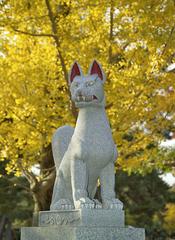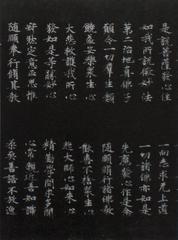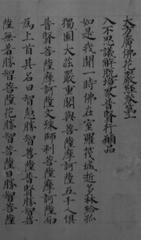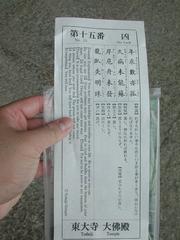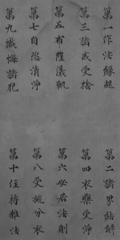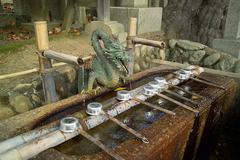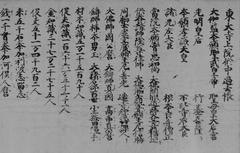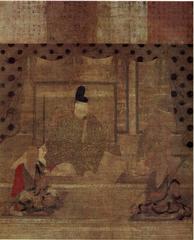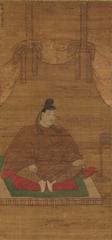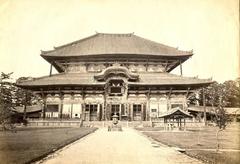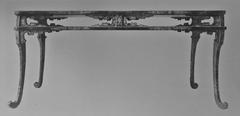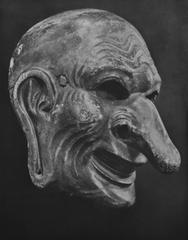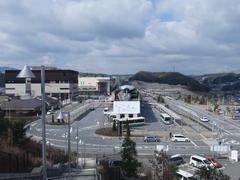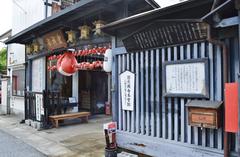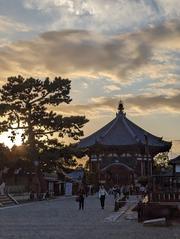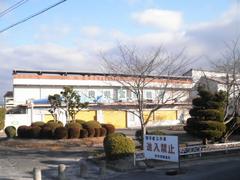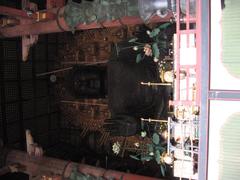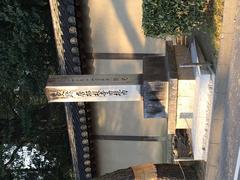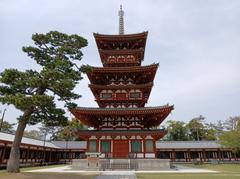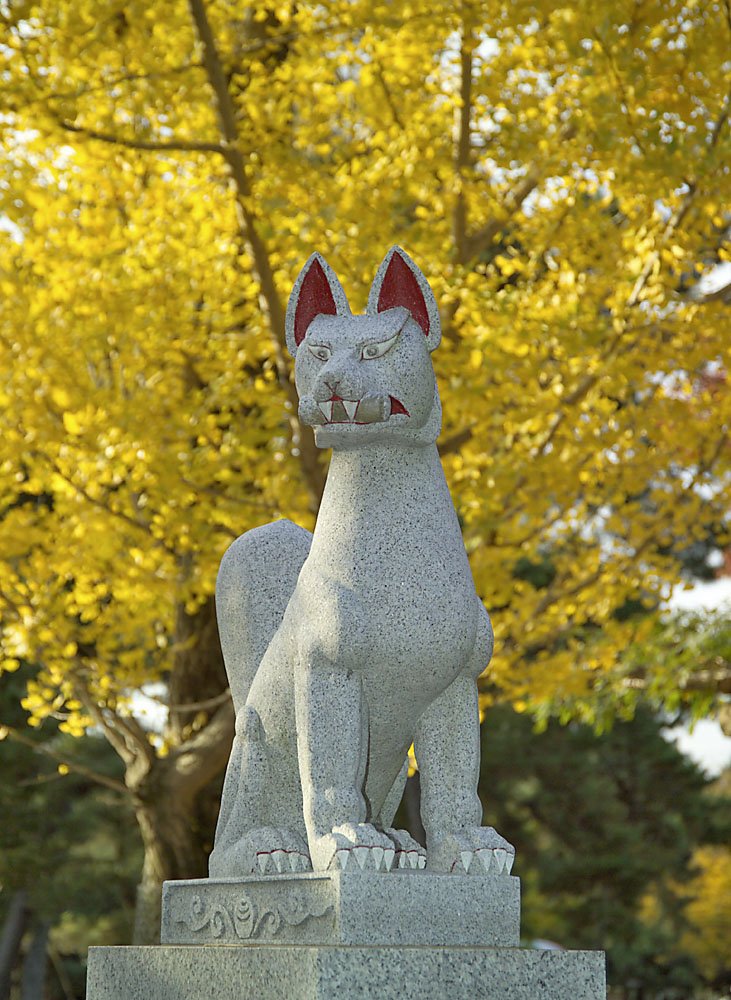
Tōdai-ji Visiting Hours, Tickets, and Historical Sites in Nara
Date: 14/06/2025
Introduction to Tōdai-ji in Nara
Tōdai-ji, situated in the ancient city of Nara, Japan, is a monumental testament to Buddhist heritage, imperial ambition, and Japanese architectural mastery. Founded in the 8th century under Emperor Shōmu, the temple is famed for housing the Great Buddha (Daibutsu)—a colossal bronze statue symbolizing national unity and spiritual protection (History Hit; Bespes). Its construction engaged over two million laborers and artisans, reflecting an unprecedented national effort that continues to resonate through Japanese culture.
As the head temple of the Kegon school of Buddhism, Tōdai-ji has been a center of religious scholarship, ritual, and artistic innovation for over twelve centuries (Cestee). Visitors are captivated not only by the Great Buddha Hall—the world’s largest wooden structure—but also by the temple’s vibrant festivals, such as the Omizutori fire ritual, and its harmonious relationship with the sacred deer of Nara Park (Japan Welcomes You).
This guide provides essential information on Tōdai-ji’s visiting hours, tickets, highlights, accessibility, and nearby attractions, ensuring a rewarding and well-prepared visit. Official resources and travel tips are linked throughout for up-to-date planning (Tōdai-ji Official; Japan Guide).
Table of Contents
- Introduction
- Historical Background
- Cultural and Religious Significance
- Architectural Highlights and Must-See Attractions
- Visiting Tōdai-ji: Practical Information
- Seasonal Highlights and Festivals
- Getting There and Orientation
- Dining and Nearby Amenities
- Safety and Practical Considerations
- Additional Recommendations
- Frequently Asked Questions (FAQ)
- Visuals and Media Suggestions
- Conclusion
- References and Further Reading
Historical Background
Foundation and Early Development (8th Century)
Tōdai-ji was established during the Nara period, a pivotal era for Buddhism in Japan. Emperor Shōmu (r. 724–749) initiated the temple’s construction to foster national unity and spiritual protection amid natural disasters and unrest (History Hit; Wikipedia). In 743 CE, he decreed the creation of the Great Buddha, and by 752 CE, the monumental bronze statue—standing approximately 14.7 meters tall—was consecrated (Bespes). The complex, inspired by Tang dynasty architecture, included two seven-story pagodas and the massive Great Buddha Hall (Daibutsuden) (Wikipedia).
Medieval Turmoil and Reconstruction
Tōdai-ji’s spiritual and political influence made it a target during conflicts. In 1180, the temple was devastated during the Genpei War, prompting major reconstruction under monk Shunjōbō Chōgen, who oversaw the recasting of the Great Buddha and rebuilding of the Daibutsuden (History Tools). Subsequent fires, especially during the Sengoku period, led to further rebuilding. The current Great Buddha Hall was completed in 1709 and remains the largest wooden structure worldwide (Bespes; Wikipedia).
Modern Era: Meiji Reforms to Present
The Meiji era brought challenges, including government-mandated separation of Shinto and Buddhism and loss of temple lands (Bespes). Despite these, Tōdai-ji persisted as the head temple of the Kegon school and was designated a UNESCO World Heritage Site in 1998 (Bespes). Continuous restoration efforts ensure the temple’s preservation (History Tools).
Cultural and Religious Significance
Tōdai-ji is central to Japanese Buddhism, serving as the head temple of the Kegon school and playing an integral role in scholarship, ritual, and art (Bespes). The annual Omizutori ceremony at Nigatsudō, performed for over 1,200 years, marks spring’s arrival and is a significant pilgrimage event. The Shōsōin treasure house further highlights Tōdai-ji’s role as a hub for cultural exchange along the Silk Road (Bespes).
Architectural Highlights and Must-See Attractions
Daibutsuden (Great Buddha Hall)
The Daibutsuden is the architectural heart of Tōdai-ji and one of the world’s largest wooden buildings, rebuilt in 1709 and measuring 48 meters high, 57 meters long, and 50 meters wide (Rough Guides; Nippon.com). Inside, the immense bronze Daibutsu sits serenely, flanked by Bodhisattvas and guardians (Japan Travel Explorer). A pillar with a hole at its base, matching the Buddha’s nostril, is believed to grant enlightenment to those who pass through (Tourist Japan).
Nandaimon (Great South Gate)
This imposing wooden gate, rebuilt in the 12th century, is guarded by two fierce Niō statues—masterpieces of Buddhist sculpture and designated National Treasures (Japan Travel Explorer; Nippon.com).
Nigatsudō Hall
Nigatsudō offers panoramic views of Nara and is renowned for the Omizutori ceremony each March (Kanpai Japan).
Hokke-dō and Sub-Temples
Explore the Hokke-dō (the oldest building in the complex), Kaidan-in (the ordination hall), and other sub-temples, each with unique historical and artistic features (Nara City Tourism; Kanpai Japan).
Tōdai-ji Museum
Opened in 2011, the museum displays temple treasures, Buddhist statues, and historical artifacts (Kanpai Japan).
Belfry and Other Features
The temple’s belfry and Kagami Pond offer moments of reflection and beauty (Nippon.com).
Nara Park and Sacred Deer
The temple is nestled within Nara Park, home to sacred sika deer—considered messengers of the gods in Shinto tradition (Tourist Japan; Japan Travel Explorer).
Visiting Tōdai-ji: Practical Information
Opening Hours
- Great Buddha Hall:
- April–October: 7:30 am–5:30 pm
- November–March: 8:00 am–5:00 pm
- Tōdai-ji Museum:
- April–October: 9:30 am–5:30 pm (last entry 5:00 pm)
- November–March: 9:30 am–5:00 pm (last entry 4:30 pm)
- Nigatsu-dō/Sub-Temples: Hours may vary (Tōdai-ji Official; Zimmin Around the World).
Admission Fees
- Great Buddha Hall: Adults ¥800; children (6–12 years) ¥400
- Joint Pass (Hall + Museum): Adults ¥1,200; children ¥600
- Audio Guide Rental: ¥500 (Tōdai-ji Official)
Accessibility
- The main paths and Daibutsuden are wheelchair accessible. Some sub-temples require steps, but assistance and wheelchairs are available (Tōdai-ji Official).
Guided Tours and Audio Guides
- English-language guided tours and audio guides are available and recommended for a deeper experience.
Photography
- Photography is permitted in most outdoor areas and inside the Daibutsuden, but flash and tripods are prohibited. Always respect posted restrictions (Japan Guide).
Seasonal Highlights and Festivals
- Cherry Blossoms (March–April): The temple grounds are stunning during sakura season (Kanpai Japan).
- Autumn Foliage (October–November): Vibrant fall colors transform the landscape.
- Omizutori Festival (March): One of Japan’s oldest Buddhist rituals, held at Nigatsudō (Tourist Japan).
Getting There and Orientation
Access
- From Osaka/Kyoto:
- Osaka: ~45 minutes by train (via Osaka Station or Namba/Kintetsu Line)
- Kyoto: ~45 minutes by JR Nara Line or ~35 minutes by Kintetsu Kyoto Line (Japan Guide; Hey Roseanne)
- From Nara Stations:
- 30-minute walk from Kintetsu Nara Station
- Frequent buses to “Todaiji Daibutsuden” stop (Japan Experience)
Navigating the Grounds
- Clear signage in English and Japanese. The main approach leads through the Nandaimon gate to the Daibutsuden.
Dining and Nearby Amenities
- Local cuisine: Gyumabushi beef bowls, deer curry, and mochi from Nakatanidou (Klook; Hey Roseanne)
- Accommodation: Options range from ryokan to modern hotels (Klook)
Safety and Practical Considerations
- Deer: The deer are generally docile but can become persistent when fed. Always supervise children and follow safety guidance (Japan Guide).
- Weather: Most of the grounds are outdoors. Prepare for rain or sun accordingly.
- Crowds: To avoid the busiest times, visit early morning or late afternoon and avoid weekends/holidays (Travel Caffeine).
Additional Recommendations
- Combine with other sites: Kasuga Taisha Shrine, Kōfuku-ji Temple, and Isuien Garden are nearby (Trip to Japan).
- Souvenirs: The temple shop offers charms, calligraphy, and crafts.
- Events: Check the official website for ceremony schedules and special openings (Tōdai-ji Official).
Frequently Asked Questions (FAQ)
Q: Where can I buy Tōdai-ji tickets?
A: Tickets are available at entrance counters; some tours offer advance booking.
Q: What are the best hours to avoid crowds?
A: Early mornings and weekdays are ideal. Avoid weekends and public holidays.
Q: Is Tōdai-ji wheelchair accessible?
A: Yes, the main hall and paths are accessible; some sub-temples have steps.
Q: Can I take photos inside Tōdai-ji?
A: Yes, but no flash or tripods inside the Great Buddha Hall. Observe all restrictions.
Q: Are guided tours available?
A: Yes, in multiple languages.
Q: Are audio guides available?
A: Yes, for rent at the entrance.
Q: Can I feed the deer in Nara Park?
A: Yes, with special deer crackers; always follow posted guidelines.
Visuals and Media Suggestions
- Include high-quality images of the Great Buddha Hall, Nandaimon Gate, and seasonal cherry blossoms or autumn foliage, with alt tags like “Tōdai-ji Great Buddha Hall in Nara.”
- An embedded map showing Tōdai-ji’s location within Nara Park.
- Consider a virtual tour or video walkthrough for enhanced engagement.
Conclusion
Tōdai-ji stands as a living monument to Japan’s religious heritage, architectural achievement, and enduring cultural spirit. With its awe-inspiring Great Buddha, vibrant festivals, and harmonious setting among the sacred deer of Nara Park, Tōdai-ji offers visitors a journey through centuries of history and spirituality. Careful planning—regarding visiting hours, ticketing, and accessible amenities—ensures a fulfilling experience. For further guidance, download the Audiala app for curated tours and stay tuned to our updates for the latest travel tips.
References and Further Reading
- History Hit: Tōdai-ji
- Bespes: Tōdai-ji Temple Guide
- Cestee: Discover Tōdai-ji
- Japan Guide: Nara Travel Guide
- Tōdai-ji Official Website
- Kanpai Japan: Tōdai-ji
- Nippon.com: Guide to Japan
- History Tools: Tōdai-ji Legacy
- Japan Welcomes You: Nara, Tōdai-ji Guide
- Hey Roseanne: Nara Day Trip
- Travel Caffeine: Tōdai-ji Review & Tips
- Zimmin Around the World: Visiting Tōdai-ji
- Japan Experience: Tōdai-ji Temple
- Tourist Japan: Tōdai-ji Temple
- Japan Travel Explorer: Tōdai-ji
- Trip to Japan: Tōdai-ji Temple
- Klook: Tōdai-ji Temple
- Nara City Tourism: Hokke-dō
- Ancient Engineering Marvels: The Tōdai-ji Temple
- Agoda: Top 10 Unforgettable Experiences in Nara
- Journey Rambler: Tōdai-ji Temple
